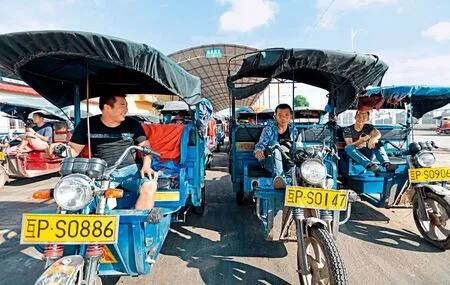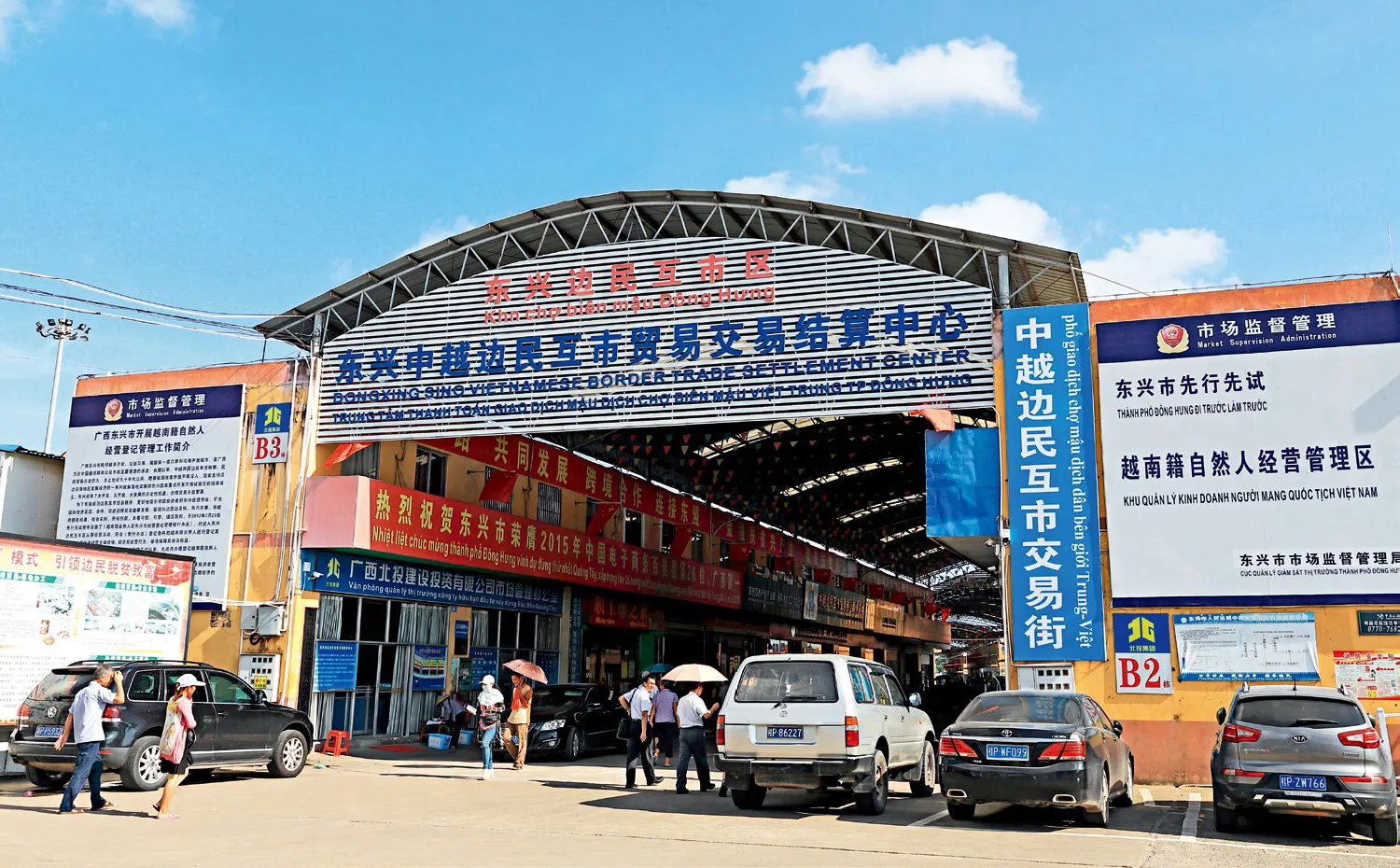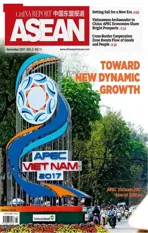DONGXING ZONE TRANSFORMS AREA TRADE
2017-11-22ByWangFang
By Wang Fang
DONGXING ZONE TRANSFORMS AREA TRADE
By Wang Fang
Border trade zone along the Beilun River facilitates exchange of goods between Chinese and Vietnamese citizens by streamlining payments and customs checks
In September, despite scorching sun and high temperatures in Dongxing,Guangxi Zhuang Autonomous Region, the border trade zone in the city near the Beilun River,which forms the boundary between China and Vietnam,remained crowded with people and vehicles.
Back in the 1990’s, the Chinese government began to encourage local enterprises in its border areas to conduct “small-scale cross-border trade” and allow local residents to carry out transactions limited to certain amounts in cross-border trade zones. Currently, Dongxing is China’s largest border trade zone, and cross-border trade has become one of the mainstay industries in the city.
Surging Trade Volume
Upon entering the Dongxing border trade zone, what first comes into sight are four structures with arched roofs,which look like farmers’markets from a distance. All shops there have signboards in both Chinese and Vietnamese.Unlike other markets, only Vietnamese citizens are allowed to run businesses there. After completing quality inspection and quarantine procedures,Vietnamese vendors may store their goods in the warehouses here, making them available to Chinese dealers or buyers.

Vendors wait for customs clearance at the Dongxing border trade zone.
Every morning, Lu Thi Nhat,a Vietnamese woman in her thirties, takes a bus from Mong Cai in Vietnam to Dongxing,where she does business at the border trade zone. She can speak fluent Chinese. Any Vietnamese holding an entryexit permit for foreigners issued by China can live in Dongxing for three months at a time and do business there, Lu said.
“I’ve done business for a total of four years here, mainly selling Vietnamese products such as candies, biscuits and jackfruit,” Lu said. In the past, her shop items sold well only during the Spring Festival period, but now her business is bullish throughout the year, which is largely attributed to the policy of expanding openingup adopted by the Chinese and Vietnamese governments in 2012.The maximum daily sales volume of her shop can reach 50 tons,and she earns a net income of over 60,000 yuan (US$9,070) per month.

The Dongxing border trade zone remains bustling throughout the year.
There are many Vietnamese vendors like Lu in the Dongxing border trade zone. At present,nearly 2,000 transactions are made in the zone every day.Transactions valued below 8,000 yuan (US$1,210) are exempted from taxes. Daily trade volume often exceeds 10 million yuan(US$1.5 million).
“The border trade zone began operation in 2009, and now consists of three markets for agricultural products, seafood products and fruits, respectively,”explained Qi Yousheng, general manager of 89bay.com, which is responsible for the operation of the trade zone. The first phase of the border trade zone covers 17.3 hectares and offers more than 390 stalls. Each border resident can be exempted from import tariffs for goods valued as much as 8,000 yuan (about US$1,210) a day. Trade volume in the Dongxing border trade zone reached US$1.8 billion in 2016. In light of surging border trade, the second phase of the border trade zone with an area of 100 hectares will be completed and put into operation at the end of 2017.
Integrated Settlement
Dongxing has achieved a number of firsts in terms of China-Vietnam cross-border trade. The city is home to China’s first CNY-VND pilot exchange center, first ASEAN currency service platform and first China-ASEAN cross-border insurance2
1,0,00000-
The settlement center handles1,000-2,000 transactionsdaily,with sales volume totaling about20 millionyuan(US$3 million). In 2016 alone, the settlement center handled 998,998 transactions,totaling12.278 billion yuan(US$1.9 billion).service center. The city has taken the lead in a series of innovations and reforms, considerably boosting the development of cross-border trade.
The transaction settlement center of the Dongxing border trade zone is a busy place. Tan Xiangwu, a local resident, bought some shrimp from a Vietnamese vendor. He was waiting to pay in cash at the settlement center before receiving bill of lading,which he used for delivery of goods at the warehouses. The process is clear, just like paying at the cash register in a shopping mall, instead of paying directly to the vendor. “This is safer and more convenient,” Tan explained.In the past, Vietnamese vendors and Chinese buyers transacted face to face, which often led to difficulties caused by the language barrier.
It’s not just the Chinese citizens working in the zone who find the process convenient.According to Vietnamese vendor Tran Thuong Le, since the establishment of the transaction settlement center, customers have begun to pay at the center by showing shopping receipts,and vendors receive their money from the settlement center every evening after they close their stores for the night. This also brings convenience to Vietnamese vendors.
According to Wang Jingwu, deputy director of the administrative office of the Dongxing National Key Development and Openingup Experimental Zone, since its establishment in 2012, the transaction settlement center has significantly facilitated transaction and settlement in the border trade zone. Chinese border residents who bought goods from Vietnamese vendors can pay in RMB at the transaction settlement center by showing their IDs and bills and then pick up the goods from the warehouses.
“The settlement is made via state-owned banks, and transaction information is connected to the customs declaration system and the currency exchange system of the State Administration of Foreign Exchange, thus facilitating supervision,” Wang added. Such measures taken by Dongxing propel border trade cooperation between China and Vietnam and have thus won acclaim from both Chinese and Vietnamese border residents.
The settlement center handles 1,000-2,000 transactions daily,with sales volume totaling about 20 million yuan (US$3 million).In 2016 alone, the settlement center handled 998,998 transactions, totaling 12.278 billion yuan (US$1.9 billion).
Owing to the rapid development of cross-border e-commerce in Dongxing, border residents can buy commodities faster and more conveniently.“Now Chinese border residents can make deals online directly with Vietnamese vendors via smartphones or PCs and even pay online, instead of waiting in long lines at the settlement center,”Qi added. “This is much more efficient.” Previously, buyers needed to queue for three or four hours to pay at the settlement center, but now it takes only a few minutes. The settlement center is optimizing its mobile payment platform, with which buyers can use their mobile phones and fingerprints, greatly enhancing the efficiency of border trade.
Alongside the implementation of the Belt and Road Initiative and the construction of the Dongxing experimental zone,China-Vietnam border trade has increased faster and faster.Over the last three years, the trade volume of the Dongxing border trade zone saw year-onyear increases of 12 percent,34 percent and 102.9 percent,respectively.
